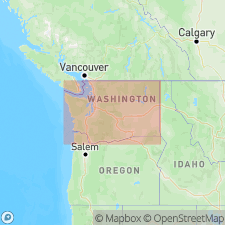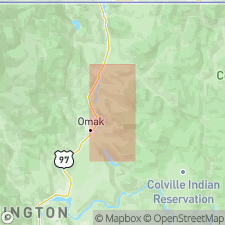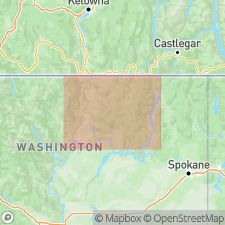
- Usage in publication:
-
- Tonasket Gneiss
- Modifications:
-
- First used
- AAPG geologic province:
-
- Okanogan province
Summary:
First use of the Tonasket Gneiss. Consists of variable group of gently dipping banded migmatitic and feldspathic gneisses; basic gneisses; subordinate isochemically metamorphosed amphibolites and lime-silicate rocks and mylonitized derivatives of these rocks. Occurs north of the Patterson Lake Gneiss (new). Intruded by hypabyssal dike. (B1350)
Source: GNU records (USGS DDS-6; Menlo GNULEX).

- Usage in publication:
-
- Tonasket Gneiss
- Modifications:
-
- Named
- Dominant lithology:
-
- Gneiss
- AAPG geologic province:
-
- Okanogan province
Summary:
Tonasket Gneiss is applied to gneisses previously described as "Coleville batholith" gneisses by Waters and Krauskopf (1941). Gneisses contain subordinate isochemical rocks, mainly amphibolites with small amounts of calcsilicate rocks; basic gneisses; highly variable group of migmatitic and feldspathic gneisses; and mylonitized derivatives of those rocks. Stratigraphic position of gneisses not yet determined because all boundaries are in fault contact with rocks of Triassic to Tertiary age. Tonasket Gneiss known to occupy area of at least 900 sq mi and is small part of plutonic complex that extends across northern Washington into Canada. (B1350)
Source: GNU records (USGS DDS-6; Menlo GNULEX).

- Usage in publication:
-
- Tonasket Gneiss*
- Modifications:
-
- Adopted
- AAPG geologic province:
-
- Okanogan province
Summary:
Tonasket Gneiss of Snook (1965) is adopted and is restricted to layered gneiss. As such, it excludes the enveloping granitoid gneiss. Type area is designated. Age is Late Cretaceous.
Source: GNU records (USGS DDS-6; Menlo GNULEX).

- Usage in publication:
-
- Tonasket Gneiss*
- Modifications:
-
- Age modified
- AAPG geologic province:
-
- Okanogan province
Summary:
Age of the Tonasket Gneiss is Paleocene and early Eocene.
Source: GNU records (USGS DDS-6; Menlo GNULEX).
For more information, please contact Nancy Stamm, Geologic Names Committee Secretary.
Asterisk (*) indicates published by U.S. Geological Survey authors.
"No current usage" (†) implies that a name has been abandoned or has fallen into disuse. Former usage and, if known, replacement name given in parentheses ( ).
Slash (/) indicates name conflicts with nomenclatural guidelines (CSN, 1933; ACSN, 1961, 1970; NACSN, 1983, 2005, 2021). May be explained within brackets ([ ]).

